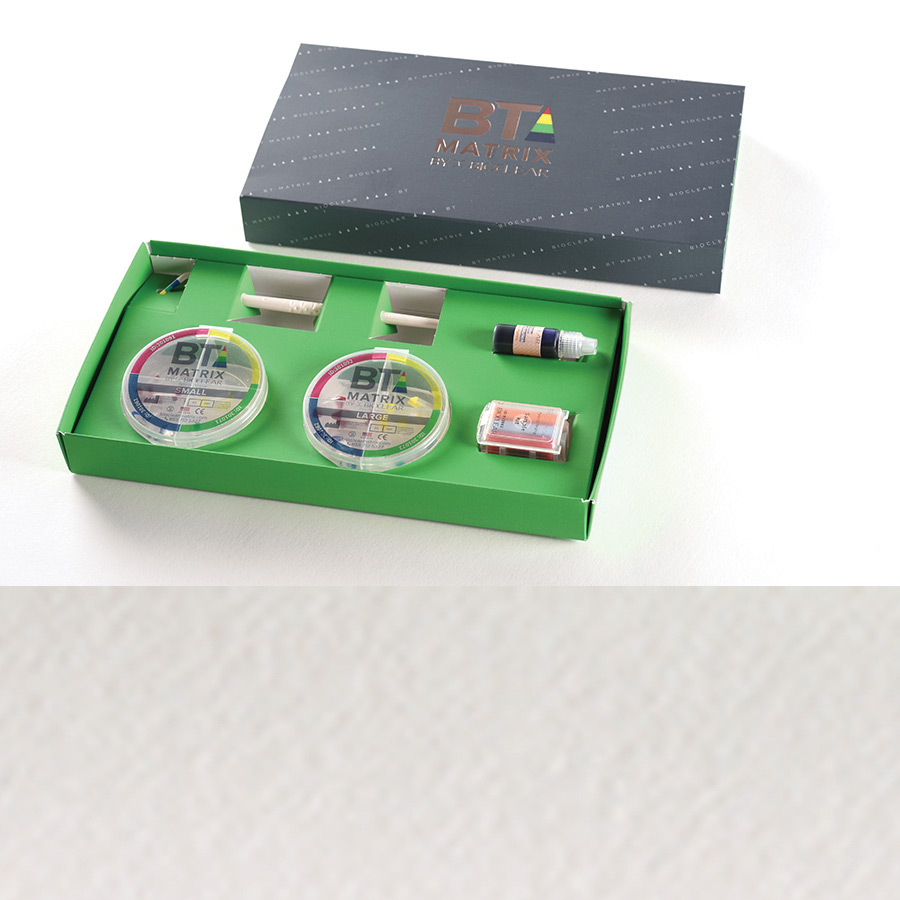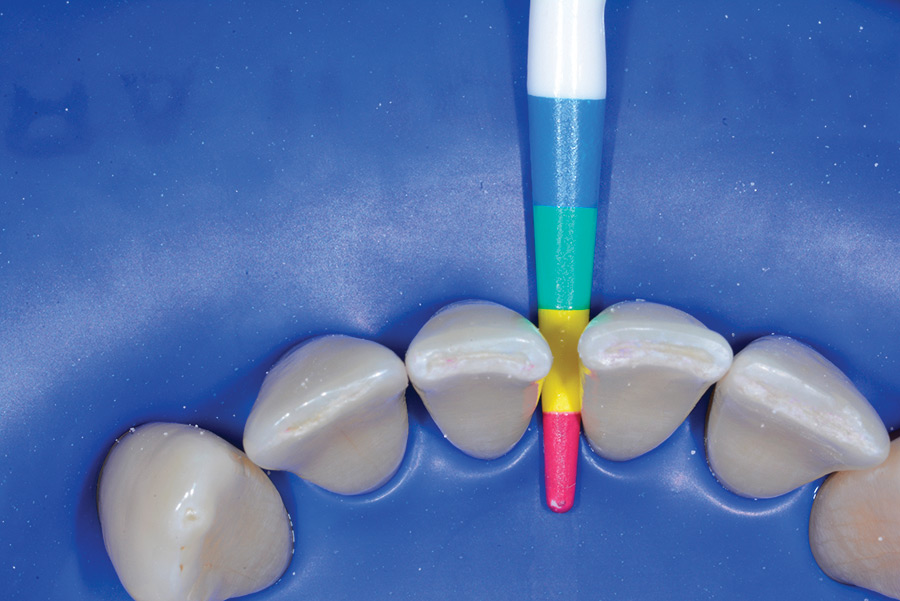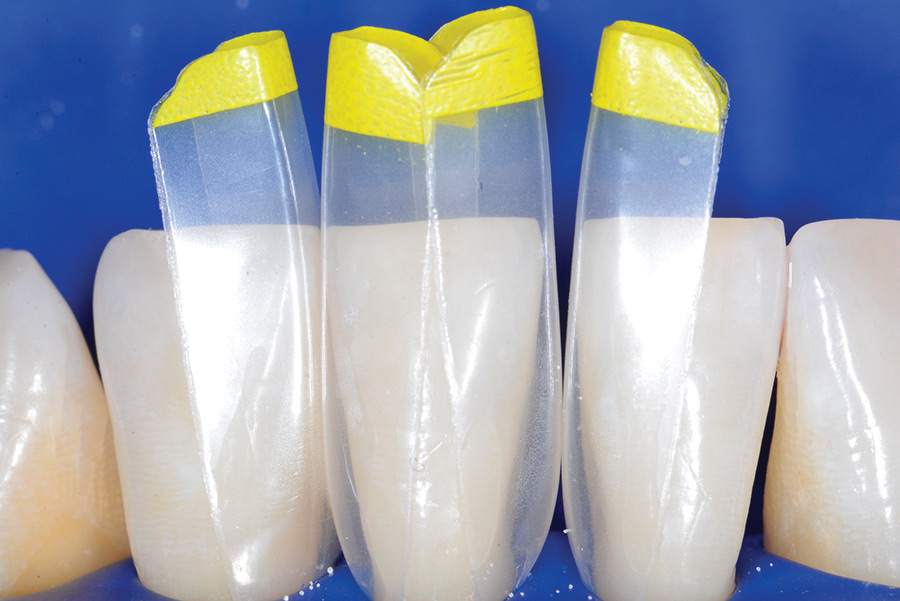Orthodontic treatment in adults is very different than that for adolescents. A significant number of finished ortho cases, are in truth, not finished in the eyes of the patient. Patients that have undergone oftentimes lengthy orthodontic treatments are typically motivated by dental health and esthetics. It simply doesn’t make sense to these patients to be in treatment for so long and make personal sacrifices to journey through orthodontic therapy, to then turn around and “finish” by covering the teeth with porcelain laminates. Especially if the laminates will require, in their words, “grinding my teeth down to nubs”. While this may be an overstatement of the reduction of a tooth, most rational patients will choose an additive, rather than subtractive restorative approach. Is this a widespread problem? The prevalence of adult orthodontics has risen approximately 40 per cent since 1996,1 and at least 40 per cent of adult orthodontics results in black triangles.1,2 Many of those patients view black triangles as a bigger problem than crowded teeth and sometimes report that they wish they had not embarked on the orthodontic treatment and want to turn back the clock. Most of these unhappy post-orthodontic outcomes resulted from lack of informed consent regarding the possibility of Black Triangles and also incomplete treatment plans combined with inexperienced general dentists dabbling in orthodontics.
Why is Canada leading the world in the percentage of dentists performing the Bioclear Method?
Clinical Research Dental was the first Bioclear dealer outside of the USA and has shown a strong commitment by creating a plethora of Bioclear courses in Canada over the past 11 years. Recently, 3M Oral Care signed an agreement with Bioclear to co-brand and promote the Bioclear Method using the preferred adhesives and resin composites of the Bioclear Method, Scotchbond Universal, Filtek Supreme Ultra Restorative and Flowable composite, and Filtek One. With this powerful commitment to education and hands-on training, it is not surprising that Canada leads the way. Recently, dental schools such as Université de Montréal and McGill University are incorporating some or all of the Bioclear Method into their curriculum which embraces modern, non-GV Black, infinity edge style cavity preparations restored with injection molded composite resins. The GPR program at University of Alberta was the first program in Canada to adopt the Bioclear Method.
The Functional and Esthetic Impairment Resultant Unfamiliar Negative Space
Negative space is the space surrounding and defining the boundaries of positive space occupied by an object.3 The human visual system is more sensitive to contrast than absolute luminance. The human eye sees contrast between black and white more readily than soft-color contrasts. As a result, our visual focus on an area or object is enhanced when surrounded by the stark contrast of negative space. Dentists often fixate on the color or colors of the tooth. Our patients fixate on the shape and any darkness around that shape. Unfamiliar negative space is darkness where it doesn’t belong. To a patient’s eyes it looks like decay and disease, even in the tiniest of black triangles. The patient highlighted (Fig. 1) in this article lives in Texas and contacted my west coast (Tacoma USA) office after being disappointed at her post-orthodontic result. While better than before the orthodontic treatment, the patient felt like the result was far from ideal. She researched the internet options for treatment of Black Triangles and discovered the Bioclear Method and our Bioclear Clinic. She and her family flew for two days of treatment. She returns annually for prophylaxis which affords us the opportunity for annual follow up photographs (Figs 1-8). Here are a few comments from the patient, Bridgette: “Being a nurse, I research everything and was becoming very worried that I would never find a solution! I hated the black spaces between my lower teeth but was repeatedly told that there was nothing that anyone could do. I am a person that laughs all the time and the spaces were becoming noticeable. Now that the Bioclear treatment is finished the teeth feel perfect! They feel like natural teeth but smoother.”
Fig. 1

Fig. 2

Fig. 3

Fig. 4

Fig. 5

Fig. 6

Fig. 7

Fig. 8

The author has treated hundreds of Black Triangles from several countries including Canada and several states in the USA. Patients are aggressively seeking Bioclear treatment for Black Triangles along with other esthetic dilemmas. Today there are 102 Certified Bioclear providers in Canada that have traveled for intensive hands on training at the Bioclear Learning Center in Tacoma. In addition, there are approximately 2,000 Canadian clinicians that have taken a Bioclear course at a CRD sponsored event. This makes Canada, according to internal research at Bioclear, the leading country per capita in the world performing Injection molding composite dentistry with the Bioclear Method.
Injection Molding with the Bioclear Method Today
Injection molding is made exponentially easier with heated composite. The HeatSync composite heater is shown (Fig. 9) loaded with Unidose compules with Filtek Supreme Ultra Restorative “Body” shade regular composite and the matching Filtek Supreme Ultra Flowable Restorative in a syringe. In 2019 a simpler and prescriptive Bioclear Black Triangle kit was introduced to treat maxillary and mandibular black triangles. Because of the popularity of the new kit, I will show a similar case with the new Black Triangle Kit. The kit is shown in Figure 10 with the four important components, the large tooth tub and small tooth tub of color coded for curvature types, a gauge with corresponding colors that binds at one of four triangle widths, contact sanders, and disclosing solution. Additional components are explained in the body of the article. Before the rubber dam is placed, the TruContact sanders are used to groom to remove calculus and to lighten the tension of the contact areas to will allow the matrices to seat fully (Fig. 12). Once the rubber dam is placed, the teeth are disclosed and then blasted with an air/water/abrasive slurry of aluminum try-hydroxide (Figs. 11 & 13) with the Bioclear Blaster. This step is critical because the 37 per cent phosphoric acid used to condition the teeth does not remove the soft, sticky biofilm that covers the tooth. In addition, it is critical to remove the fluoride pellicle on the tooth to achieve an ideal bond. Nowhere is biofilm removal more challenging and more critical than the interproximal area where access by traditional scalers and prophy cups is difficult.
Fig. 9

Fig. 10

Fig. 11

Fig. 12

Fig. 13

Next, the Black Triangle gauge inserted buccal-lingually below the contact to assess the mesio-distal size of the black triangle (Figs. 14 & 15). The gauge will bind at one of the four colors that correspond to curvature shapes of appropriate matrices with the matching color. In this case the midline embrasure between 31 and 41 was measured to a “yellow” space and the central-lateral space between the 31 and the 32 measured smaller with a “pink“ portion of the gauge. Then a pair of correspondingly colored Bioclear Black Triangle matrices are tried in for each embrasure. Although we measure and pair the matrices for each embrasure, the injection molding is performed one tooth at a time to allow for a monolithic, stain resistant outcome. There are two cups of color-coded matrices, one cup is for ”small” teeth and one cup is for “large” teeth. For this lower arch, lower incisors are considered small teeth and the canine teeth are considered as large.
Fig. 14

Fig. 15

Tooth #41 is injection molded first. The yellow matrices are placed at the midline (Fig. 16). The other embrasures were a mix of yellow and pink gauged spaces. “Shield” matrices (inactive matrices that shield the neighboring teeth) are on either side of the tooth and will later be used as active matrices. These shield matrices help maintain the embrasure shape as the active matrices, or “aquarium” becomes pressurized and secondarily aid the clinician by keeping the neighboring tooth clean from resin contamination during injection molding with the active matrices. The matrixed tooth #41 is acid etched, rinsed and dried. Scotchbond Universal adhesive is placed on enamel, massaged into dentin for 20 seconds, air thinned but not light cured. Then heated Filtek Supreme Ultra Flowable, followed with heated Filtek Supreme paste are injected into the “aquarium” (Fig. 17). The matrices are massaged back to shape with the unique paddle instrument, and gingival excess in the “umbilicus” area is brushed away with dry brushes. The supragingival excess in the umbilicus is maintained as to not disturb the composite. Little to no hand manipulation of the composite is the goal with injection molding. Once thoroughly light cured, the shepherd matrices and the active matrices are removed. The excess areas are quickly amputated with a coarse flame bur (Komet) dry. Then the tooth is taken to 80% of the final shape with the 3M Sof-Lex coarse disc. Then we move on and set the “aquarium matrices and shield matrix the next teeth, #31 and 32 (Fig. 18). The process is repeated one tooth at a time until the canine spaces are closed.
Fig. 16

Fig. 17

Fig. 18

Warming up to the concept of heated of composite
Pre-operative radiographs and four-year follow up radiographs (Figs. 6 & 7) demonstrate the exquisite adaption of composite to the root of the tooth apical to the gingival sulcus. Those who are first-time observers of post-operative bitewing radiographs of well-done Bioclear cases are often surprised at the marginal integrity, and the ability to inject composite into a very acute matrix-tooth interface. Heating of both the flowable and paste composites is incredibly helpful when doing injection molded composite dentistry. 3M has published and/or commissioned studies to demonstrate the safety and efficacy of warming for select 3M composites.4-6 In short, heating of Filtek Composites is proven be safe to both the composite and the patient.7 Two other independent studies by Dr. Richard Price at Dalhousie and Alex Fok at MDRCBB in Minnesota have shown significant reduction in voids when the Bioclear method with heated Filtek flowable and paste composites are utilized, when compared cold hand layered composites. In all there are four keys to achieving these types of results on a routine basis:
The Final Step: The Rock Star Polish
There are three phases of the final polish. First a worn Sof-Lex XT disc is used to create a matte finish and to remove any deep scratches left by the diamond bur. Next Magic Mix (Bioclear) is used in a disposable cup to create omni-directional finer scratches. Next, the teeth are carefully cleaned off and then a diamond impregnated cup (RSP Polisher Bioclear) is used dry with light pressure. Care should be taken with any polisher used dry, as it can create ferocious heat. Then the same diamond impregnated cup is used in the final segment with copious air-water spray and heavy pressure to get the ultra-glossy appearance that sets this apart from the often-grainy finish of “bonding”.
Esthetic transformation is not a new concept in restorative dentistry. However, the ability to injection over-mold a human tooth with heated multi-viscosity resins in precise matrices with an exquisite gingival seal, and without cutting the tooth to accommodate indirect ceramics, is new. The reader is encouraged to learn more online and/or take a hands-on training if interested. The reader can contact Clinical research Dental, 3M Dental, or Bioclearmatrix.com for more information.
References
- Kurth JR, Kokich VG. Open gingival embrasures after orthodontic treatment in adults; prevalence and etiology. Am J Orthod Dentofacial Orthop. 2001;120;116-123
- Tanaka OM, Furquim BD, Pascotto RC, et al. The dilemma of the open gingival embrasure between maxillary central incisors. J Contemp Dent Pract. 2008;9:92-98
- Kim J. Clark D. Full mouth black triangle treatment protocol. Dentistry Today. Aug 2017; 72-77
- Physical and Esthetic Properties of a Warmed Dental Composite, M. Agre et. al., J Dent Res Vol #98A, Abstract #1670, 2019
- Gravimetric Extraction of Warmed and Room Temperature Experimental Composite, T. Dunbar et. al., J Dent Res Vol #98A, Abstract #1877, 2019
- Fatiguing and Preheating Effect on Mechanical Properties of Composite Resins, A. Abdulmajeed al., J Dent Res Vol #98A, Abstract #1879, 2019
- 3M composites are biocompatible according to ISO 10993-1:2018 based on a review by a board-certified toxicologist. Warmed composite transfers minimal heat to the pulp (Daronch, et. al.* and 3M internal testing)
About the Author
 Dr. Clark is director of Bioclear Learning Centers International. He founded the Academy of Microscope Enhanced Dentistry, creates curriculum for dental schools, and has lectured in 25 countries. He developed the Bioclear Matrix System for placement of biologically appropriate, esthetically pleasing direct composite restorations for facilitating Injection Molding of the Clark Class I and Class II preparations, diastema closure and black triangle elimination combined with papilla regeneration. The Clark Class I and Clark Class II preparations and restorations are now being evaluated in seven in vitro studies. He is preparing a long-term clinical outcome study. He owns several US patents. He published the first guide to dentinal and enamel cracks based on clinical microscope dentistry (16X magnification).
Dr. Clark is director of Bioclear Learning Centers International. He founded the Academy of Microscope Enhanced Dentistry, creates curriculum for dental schools, and has lectured in 25 countries. He developed the Bioclear Matrix System for placement of biologically appropriate, esthetically pleasing direct composite restorations for facilitating Injection Molding of the Clark Class I and Class II preparations, diastema closure and black triangle elimination combined with papilla regeneration. The Clark Class I and Clark Class II preparations and restorations are now being evaluated in seven in vitro studies. He is preparing a long-term clinical outcome study. He owns several US patents. He published the first guide to dentinal and enamel cracks based on clinical microscope dentistry (16X magnification).
RELATED ARTICLE: Finishing Orthodontics for Undersized Teeth: The Bioclear Method












